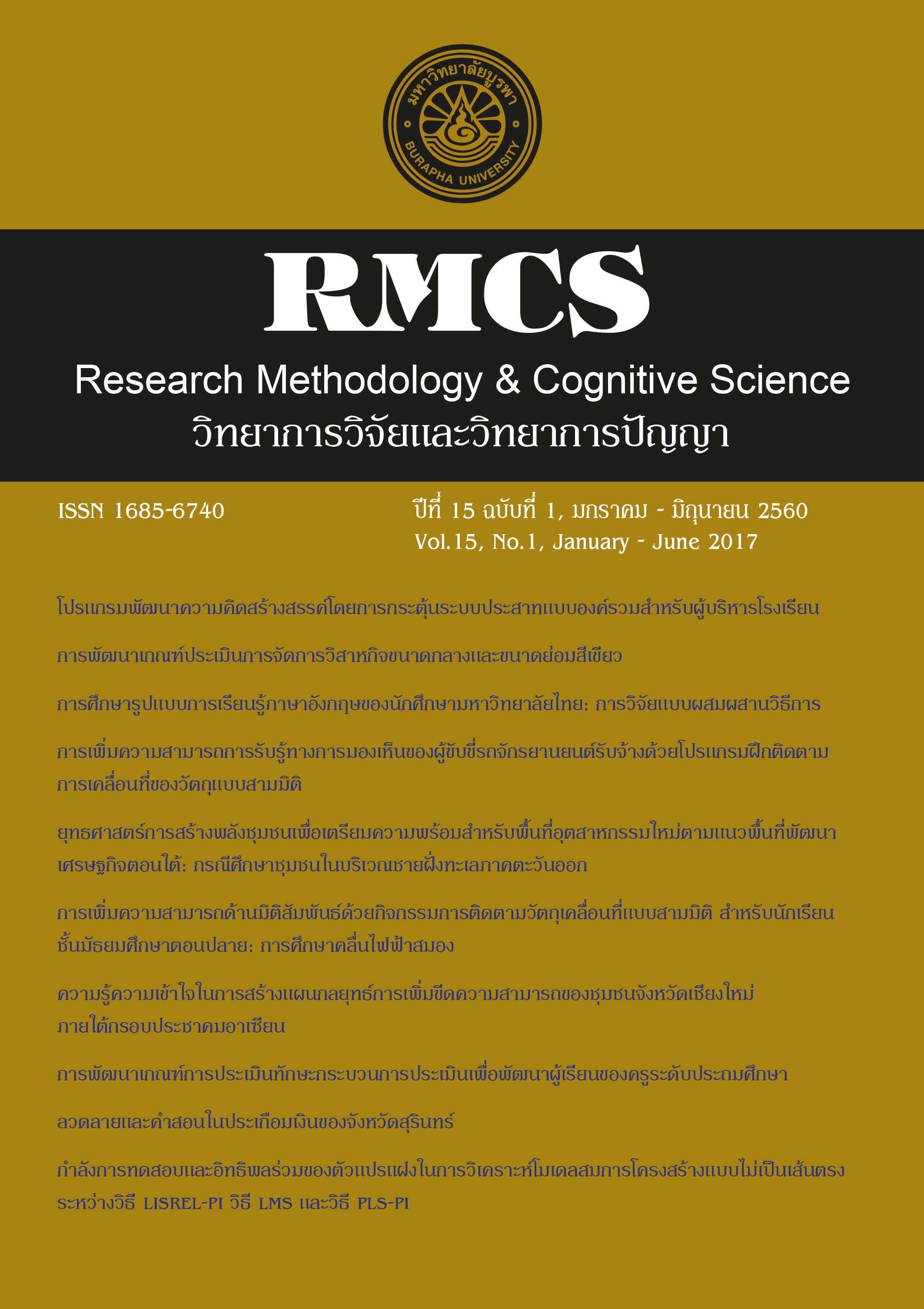การเพิ่มความสามารถการรับรู้ทางการมองเห็นของผู้ขับขี่รถจักรยานยนต์รับจ้างด้วยโปรแกรมฝึกติดตามการเคลื่อนที่ของวัตถุแบบสามมิติ Enhancing the Visual Perception Ability of Motorcycle Taxi Riders Using a 3D Motion Object Tracking Training Program
Main Article Content
บทคัดย่อ
การมองเห็นเป็นสิ่งสำคัญที่สุดและส่งผลต่อความปลอดภัยในการขับขี่รถจักรยานยนต์ ผู้ขับขี่รถจักรยานยนต์รับจ้างต้องมีความสามารถในการมองเห็น ตัดสินใจ และมีสมาธิจดจ่อ มีความสามารถด้านมิติสัมพันธ์และการควบคุมรถ การวิจัยนี้มีวัตถุประสงค์เพื่อเพิ่มความสามารถการรับรู้ทางการมองเห็นของผู้ขับขี่รถจักรยานยนต์รับจ้างด้วยโปรแกรมฝึกติดตามการเคลื่อนที่ของวัตถุแบบสามมิติ และศึกษาผลของการฝึกติดตามการเคลื่อนที่ของวัตถุแบบสามมิติ โดยการเปรียบเทียบความแตกต่างของคะแนนความสามารถการรับรู้ทางการมองเห็นก่อนกับหลังการฝึกระหว่างกลุ่มทดลองกับกลุ่มควบคุม กลุ่มตัวอย่างเป็นอาสาสมัครผู้ขับขี่รถจักรยานยนต์รับจ้างในตำบลแสนสุข อำเภอเมือง จังหวัดชลบุรี จำนวน 60 คน สุ่มเข้ากลุ่มทดลองและกลุ่มควบคุม ด้วยวิธีการสุ่มอย่างง่าย แบบแผนการทดลองเป็นแบบสุ่ม 2 กลุ่ม วัดก่อนและหลังการทดลอง เครื่องมือที่ใช้ในการวิจัยประกอบด้วย โปรแกรมฝึกติดตามการเคลื่อนที่ของวัตถุแบบสามมิติ และแบบวัดความสามารถการรับรู้ทางการมองเห็น (DTVP-A) กลุ่มทดลองใช้ระยะเวลาในการฝึก ครั้งละ 30 นาที สัปดาห์ละ 2 ครั้ง เป็นเวลา 5 สัปดาห์ วิเคราะห์ข้อมูลด้วยค่าความถี่ ร้อยละ ค่าเฉลี่ย ส่วนเบี่ยงเบนมาตรฐาน และสถิติทดสอบที (t-test)
ผลการวิจัยปรากฏว่า กลุ่มทดลองมีคะแนนความสามารถการรับรู้ทางการมองเห็นหลังการฝึกติดตามการเคลื่อนที่ของวัตถุแบบสามมิติ ดีขึ้นกว่าก่อนการฝึกติดตามการเคลื่อนที่ของวัตถุแบบสามมิติ และดีกว่ากลุ่มควบคุม อย่างมีนัยสำคัญทางสถิติที่ระดับ .05 สรุปได้ว่า การฝึกโปรแกรมฝึกติดตามการเคลื่อนที่ของวัตถุแบบสามมิติอย่างต่อเนื่องช่วยเพิ่มความสามารถการรับรู้ทางการมองเห็นของผู้ขับขี่รถจักรยานยนต์รับจ้างได้
Vision is the most important sense and it affects the safety of motorcyclists. The motorcycle taxi riders must have the visual perception, decision-making, attention, and spatial abilities as well as motorcycle control. The purposes of this study were: to enhance the visual perception ability of motorcycle taxi riders by using a 3D motion object tracking training program, and to evaluate its effectiveness by comparing the difference average scores of visual perception ability between pre-and-post tests within and between experimental and control groups. Sixty motorcycle taxi riders were volunteers and recruited from Chonburi, Thailand, and they were randomly assigned to experimental and control groups. The study was a Pre-test/Post-test control group design. The instrument consisted of the 3D motion object tracking training program and Development Test of Visual Perception – Adolescent and Adult (DTVP-A). A 30-minute training session was administered for twice a week covering five weeks in total. Data were analyzed using frequency, percentage, mean, standard deviation, and t-test.
Results revealed that the experimental group had a significantly higher visual perception ability score after training. In addition, the post-treatment average score in the experimental group was significantly higher than that of the control group at the .05 level of statistical significance. In sum, the continuous training with the 3D motion object tracking program can improve the visual perception ability of motorcycle taxi riders.
Article Details
เอกสารอ้างอิง
นนทิชา ถาวรไพบูลย์บุตร. (2555). กรอบอ้างอิงการรับรู้ทางสายตา. บทความฟื้นวิชา.
(3), 25-29.
นัพวุฒิ ชื่นบาล. (2556). การศึกษาปัจจัยที่มีความสัมพันธ์กับพฤติกรรมสุขภาพของผู้
ขับขี่รถจักรยานยนต์รับจ้างในพื้นที่เขตบางเขน กรุงเทพมหานคร. กรุงเทพฯ:
สำนักงานควบคุมโรคที่ 1 กรุงเทพฯ กรมควบคุมโรค.
พรจิรา ปริวัชรากุล. (2556). แกะรอยหยักสมองมองผลกระทบการพนัน. กรุงเทพฯ: สห
มิตรพริ้นติ้งแอนด์พับลิชชิ่ง.
ยุธนา วรุณปิติกุล และ สุพิตา เริงจิต. (2550). บันทึกโฉมหน้าอุบัติเหตุรถมอเตอร์ไซค์.
มูลนิธิสาธารณสุขแห่งชาติ. กรุงเทพฯ: โรงพิมพ์เดือนตุลา.
สํานักสถิติพยากรณ์ สํานักงานสถิติแห่งชาติ. (2556). สถิติคดีอุบัติเหตุการ
จราจรทางบก จำแนกตามสาเหตุการเกิดอุบัติเหตุจากบุคคล สาเหตุจากสิ่ง
แวดล้อม และ สาเหตุจากอุปกรณ์ที่ใช้ขับขี่ ทั่วราชอาณาจักร พ.ศ. 2549 –
เข้าถึงได้จาก
http://service.nso.go.th/nso/web/statseries/statseries21.html
สำนักงานเครือช่วยลดอุบัติเหตุ. (2553, เมษายน – พฤษภาคม). จดหมายเครือข่ายลด
อุบัติเหตุ. 4(2). เข้าถึงได้จาก
http://www4.thaihealth.or.th/files/acc4-2.pdf
Brown, L., Sherbenou, R. J., & Johnsen, S. K. (2010). TONI-4, Test of
Nonverbal Intelligence. Texas: Pro-ed.
Draganski, B., & May, A. (2008). Training-induced structural changes
in the adult human brain. Behavioural Brain Research, 192(1),
-42.
Edmond, W.A., & Kennedy, T. D., (2013). An Applied Reference Guide
to Research Designs Quantitive, Qualitative, and Mixed
Methods. Far East Square. Singapore: Sage Publications.
Faubert, J. (2001). Motion parallax, stereoscopy, and the perception
of depth: Practical and theoretical issues. Critical reviews of
optical science and technology cr, 76, 168-191.
Faubert, J. (2013). Professional athletes have extraordinary skills for
rapidly learning complex and neutral dynamic visual scenes.
Scientific Reports, 3, 1154.
Frostig, M., Lefever, D. W., & Whittlesey, J. R. B. (1966).
Administration and scoring manual for the Marianne Frising
Development Test of Visual Perception. Palo Alto, California:
Consulting Psychologists Press.
Mahncke, H. W., Connor, B. B., Appelman, J., Ahsanuddin, O. N.,
Hardy, J. L., Wood, R. A., ... & Merzenich, M. M. (2006).
Memory enhancement in healthy older adults using a brain
plasticity-based training program: a randomized, controlled
study. Proceedings of the National Academy of Sciences,
(33), 12523-12528.
Neilson, J. (2015). STOPPING DISTANCE (Safe Drive Training).
[online] Sdt.com.au. Available at:
http://www.sdt.com.au/safedrive-directory-
STOPPINGDISTANCE.html [Accessed 27 Aug. 2015].
Parsons, B., Magill, T., Boucher, A., Zhang, M., Zogbo, K., Bérubé,
Scheffer, Beauregard & Faubert, J. (2014). Enhancing cognitive
function using perceptual-cognitive training. Clinical EEG and
Neuroscience, 47(1), 37-47.
Pophan, D., & Chadcham, S. (2016). Enhancing the attention of
marine non commissioned officer students using a saccadic eye
movement computer training program: An event-related
Potential Study. Research Methodology & Cognitive Science,
(2). 1-18.
Pylyshyn, Z. (2007). Multiple object tracking. Scholarpedia, 2(10),
Sternberg, R. J., & Sternberg, K. (2016). Cognitive Psychology.
Boston: Nelson Education.
Treisman, A. (1986). Features and objects in visual processing.
Scientific American, 255(5), 114-125.

